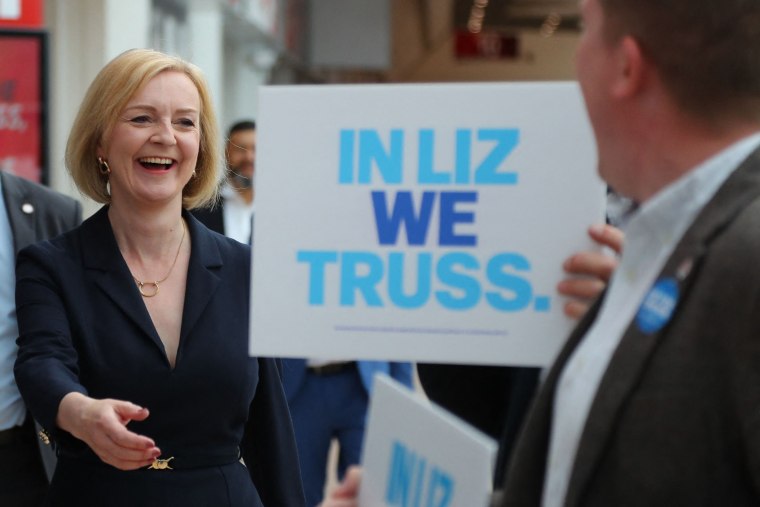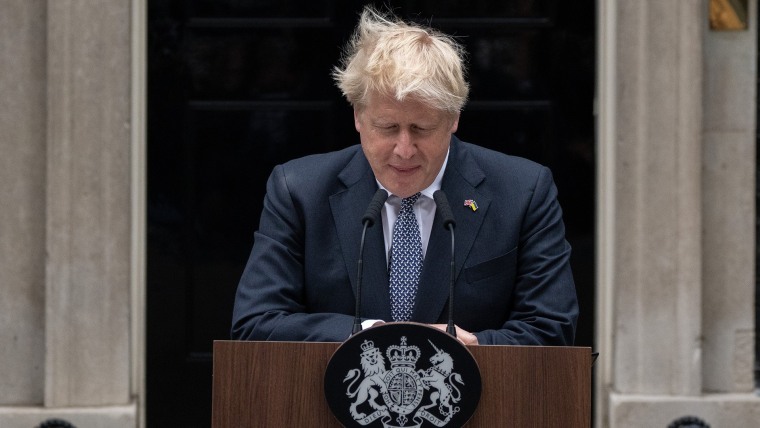Balmoral is where she is spending her traditional summer break, and the new plans mean the next prime minister will be the one making the 1,000-mile round trip, rather than the other way round.
“It’s a very significant change because if the queen was able to travel, she would,” said Craig Prescott, an expert in constitutional law and politics at Bangor University in Wales. “It’s an indication of her mobility problems, and another step on that journey we’re going on, with the queen doing less and less.”
Whom she will meet is still undecided.
Following Johnson’s resignation announcement last month, the ruling Conservative Party is currently choosing a new leader. The winner will be announced Monday, and will become the next British prime minister.
The party’s 200,000 or so members are currently voting between Liz Truss, the foreign secretary, and Rishi Sunak, the former finance minister — with Truss the clear favorite based on polling.
The winner will be the 15th British leader of Elizabeth’s reign, with all the others appointed at Buckingham Palace.
It’s a high-drama, choreographed event in which the outgoing leader travels through central London to the palace, in a black government car flanked by a police motorcade and tracked by television news helicopters.
Once the outgoing leader has tended their resignation and left the queen’s residence, the successor arrives in their own car and is formally asked by the sovereign to form a government. (The constitutional monarch has no real political power, but this is one of their remaining “prerogative powers.”)
It’s a formality, but an important moment signaling a new era for the country — a more low-key version of the pageantry and trappings surrounding the inauguration of U.S. presidents.
As part of this “theater of the British Constitution,” the soldiers standing sentry at Buckingham Palace do not salute the incoming prime minister when they enter the Audience Room, only doing so when they emerge having had their first in-office meeting with the sovereign, Prescott said.
The newly anointed prime minister then travels straight to No. 10 Downing St., their new official office and residence, to give their first speech as the country’s leader.
While the trip from Buckingham Palace takes mere minutes, the journey from London to Balmoral will take half a day by road or rail, or more than an hour by plane.
It’s unclear how the media will cover the journey to be taken by Johnson and his successor.

The queen’s 100% record of receiving the new leader at Buckingham Palace should be seen in the context of her understanding that royals need to be present and active in the public’s imagination, Prescott said. “We have to be seen to be believed,” the queen once famously remarked.
The queen could decide to delegate this responsibility to her son and heir, Prince Charles, as she did this year with the state opening of Parliament, and some of the events at her Platinum Jubilee. But the announcement signals she intends to perform the role herself.
Though it will be a first for Elizabeth, some of her predecessors have appointed prime ministers outside the capital.
In 1868, Queen Victoria appointed Benjamin Disraeli at Osborne House, a then-royal residence on the south coast Isle of Wight. In 1885, she appointed his successor, Lord Salisbury, the last prime minister of her life, at Balmoral itself.
Perhaps most strikingly, in 1908 King Edward VII appointed H. H. Asquith in a hotel room in the south of France. This had nothing to do with difficult circumstances, Prescott said, the king just didn’t want to interrupt his holiday.
CORRECTION (Aug. 31, 2022, 9:30 a.m. ET): A previous version of this article misstated when Disraeli was appointed prime minister. It was in 1868, not 1886.







